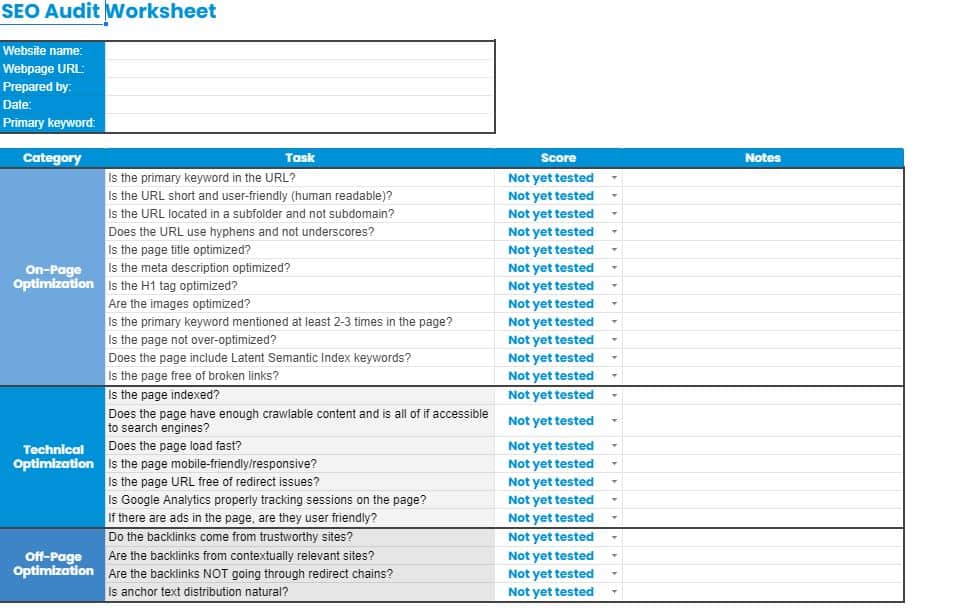Without an SEO strategy, you won’t know where you’re headed.
A good strategy helps you, your team, and your clients to understand your campaign’s long-term goals and how you’ll get there.
Creating a data-driven search engine optimization plan can help you rank top positions, increase organic traffic, and generate more sales.
In this post, you will learn how to create a step-by-step process for creating an SEO strategy from scratch. We have also added an SEO plan Template at the end for you to download to implement the steps mentioned in this post.
Ready?
Let’s get started.
1) Audit Your Current State
It will be hard to create a plan for the future if you don’t know how your site is performing now on search engine result pages. You must find your current performance across rankings and visibility to know where to move forward with an effective SEO plan.
Your website could have broken links, errors, poor sites linking to your own site, or slow page speed, affecting your SEO. Your content can also get outdated. SEO audits help you know if something is wrong and help you fix it.
Things you want to look at in your SEO audit:
- Website analytics (all the data and analytics for your website content)
- Traffic from your keywords and traffic channels.
- On-page SEO optimization – internal linking, image optimization, anchor text, page title tags, meta description, page content, user experience, and more.
- Off-page optimization – online presence outside your site, backlinks (number and quality of websites linking to yours).
- Content Audit on all related web pages
By looking at these insights, you will know what to look for and who will make the changes.
If you want to learn how to do an SEO audit in more depth, check out our SEO Audit Template. (see reference below!)
2) Set Goals & KPIs
It is important to define your goals before you launch any SEO initiative.
You need to know where you want to go so you can create a plan and find out if you’ve hit those targets.
For example, your SEO goal could be to increase organic revenue by $300,000 over the next 12 months.
The KPIs to measure would be an increase in organic traffic, click-through rates, conversion rates, and search engine rankings.
Here’s a sample template below from CMI on how you can set SEO goals:
Company’s growth strategy:
Revenue Goal for the year:
Profit for the year:
How will you achieve the growth: (e.g., new product launch, selling to existing customers, new markets, new customers):
Goals: What other objectives must the company accomplish over the next year?
Strategies: What are the new outcomes you will deliver this year? (e.g., introduce a new product, increase traffic, create a better customer experience, launch new campaigns, offer free resources, etc)
Metrics: How will you measure the progress of your marketing strategies? (e.g. increase in traffic, number of qualified leads to sales, sales from qualified leads, and number in monthly business revenue)
To make the above template simple, here are some questions you can ask:
- What are the main outcomes you want to achieve from SEO?
- When and how do you plan to hit those goals?
- Do you need new resources or team members to achieve those goals?
3) Research Your Target Audience
The first step in most content marketing campaigns is to start by defining your target audience. Understanding your target audience can help you better understand and solve their problems.
You may have a customer avatar already, but a successful content strategy needs more than that. You would need to understand how your audience searches online.
With personas, you are more likely to create the type of content that revolves around what your audience wants (which is usually different from what YOU think they want.).
So defining your audience will help you find what keywords you want to rank for and craft content that speaks to your audience.
Here’s an example of how we put together our customer avatar:
Here are some questions to know your audience better:
- What do they want?
- What are their needs and wants?
- What are their frustrations and fears?
- What are their long-term aspirations?
- What questions do they have about our industry?
- Who do they trust when looking for answers?
- Where do they go or what platforms do they hang out when looking for a solution?
Look through social media, industry forums, sales team members, and surveys to learn more about your audience.
4) Evaluate Your Competitors
Did you know hundreds of websites are competing for the same keywords as you?
Some websites have better content, link authority and more pages indexed than yours.
Before you spend your time, effort, and money optimizing for keywords, you’d want to look at how your competitors are doing in terms of keyword rankings and how you stand SEO-wise.
Here’s how you can start analyzing your competitors:
Compile a list of your competitors. This can be your direct competitors who sell the same products as you. Or indirect competitors who don’t sell the same product but have a similar audience.
First, you have to find long-tail keywords with good organic search volume that you are currently ranking with the help of keyword research tools.
By optimizing and sending links to these pages, you can rank faster than if you were to rank for a new keyword.
Your keyword strategy should be to look at your competitors to find keywords that you aren’t currently ranking for.
To filter, choose keywords that have a good volume but not high difficulty to rank.
Now you can use those keywords to either optimize or build new content.
Here are other questions to think of when you’re analyzing your competitors:
- What SEO content do my competitors have that I don’t?
- Will this content help my target audience with their needs?
- What can I do to make my features/content more valuable, faster, easier, or more comprehensive?
- What social media platforms are my target audience using and how are my competitors promoting their content?
- What are their popular landing pages and how much traffic do they get every day?
- What search query or keywords do they rank for?
- What sites are linking to them?
- What keywords you are already targeting and not currently targeting?
- What keywords would you like to rank high, what are the ranking factors, and what’s the ranking position now?
- What keywords are your competitors getting traffic for that you don’t?
Your competitors have already spent digital marketing dollars on their robust SEO plans. You can see what works and what doesn’t work by doing a simple analysis.
You can use technical SEO tools like Google Analytics, Google Search Console, Ahrefs, and Semrush to check your and your competitors’ performance on search engine result pages (SERPs).
5) Create An Effective Keyword Plan
Now that you know your target persona and competitor’s data, we can create a list of keywords to target.
When choosing your target keywords, it isn’t about volume. It is also about search intent and competition.
As you can see in the example, we use tools to get an idea of how much work it will take to rank for a keyword.
Here’s a simple process on how you can do keyword research:
- Measure the performance of the keywords you’re currently targeting in your content.
- Check if there are any keywords worth pursuing soon.
- Categorize and prioritize your target keywords. You want to have categories of relevant keywords with meaningful search volume.
If you want more information on keyword research, check out our keyword research template.
6) Create A Link Building Strategy
Once you know what keywords to use, your next step is to build links.
When building links, you should point them to web pages related to that keyword.
For example, if you’re writing a piece of content about social media, you would want the inbound links to point to that page, rather than your homepage with random marketing content.
Pro Tip: It’s better to get a few backlinks from relevant authoritative sites than from many small and unrelated sites.
Conclusion
There is always room for improvement in your SEO campaign strategy as you discover new opportunities to grow. So make sure you measure and improve your Search Engine Optimization(SEO) strategy every once in a while to hit your targets.
If you want to document your SEO strategy using the above methods, you can download our Complete SEO Strategy Template below.




